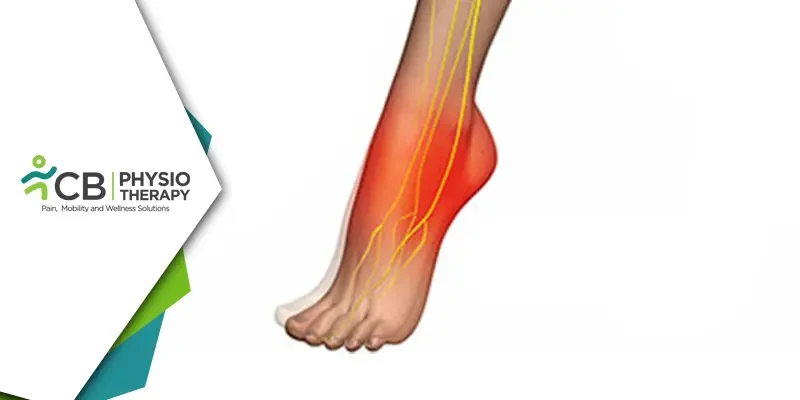Foot drop and spondylolisthesis are two conditions that can have a significant impact on a person's ability to walk and carry out daily activities. While they may seem unrelated at first glance, foot drop is actually a common symptom of spondylolisthesis, a condition in which a vertebra in the spine slips out of place and onto the vertebra below it. This can cause nerve compression in the spinal canal, which can lead to a variety of symptoms, including foot drop. In this blog post, we will explore how spondylolisthesis can lead to foot drop, and how physiotherapy can help to treat these conditions.
The peroneal nerve, which controls the muscles that lift the foot, runs through the lower back and can be affected by the compression of the spinal nerves. This can cause weakness or paralysis of the muscles that control the foot, making it difficult or impossible to lift the foot upward.
In addition to nerve compression, spondylolisthesis can also cause muscle imbalances in the legs, which can contribute to foot drop. When the vertebrae in the spine shift out of place, the muscles that support the spine may become imbalanced, leading to weakness or tightness in the muscles of the legs. This can affect the way the foot is lifted and controlled, leading to foot drop.
Spondylolisthesis can also cause changes in gait and posture, which can contribute to foot drop. When a person's posture is altered due to spondylolisthesis, the muscles in the legs may be under more strain, leading to weakness or fatigue. This can affect the ability to lift the foot and control it during walking, leading to foot drop.
In some cases, foot drop may be the first sign of spondylolisthesis, alerting the patient to the presence of the condition. It is important to seek medical attention if you experience foot drop, as it may be a symptom of a more serious underlying condition There are other treatments that can help to manage the symptoms of spondylolisthesis and foot drop. These may include the use of braces or orthotics to support the affected area, medications to manage pain and inflammation, and lifestyle changes such as weight loss and exercise. In severe cases of spondylolisthesis, surgery may be necessary to relieve pressure on the nerves in the spine. This can help to alleviate symptoms such as foot drop and prevent further nerve damage. However, surgery is usually considered a last resort and is only recommended when other treatments have been ineffective.
Role of Physiotherapy
Treatment for spondylolisthesis and foot drop often involves physiotherapy to address the underlying causes of the conditions. Physiotherapy can help to improve muscle strength, flexibility, and control, as well as address any postural imbalances or gait abnormalities. This can help to alleviate the symptoms of foot drop and prevent further damage to the nerves or muscles in the affected area. Physiotherapy can be a very effective treatment for spondylolisthesis and foot drop.
In the case of spondylolisthesis, a physiotherapist can design a customized treatment plan that addresses the patient's specific needs and goals. The treatment plan may include stretching and strengthening exercises to improve the flexibility and strength of the muscles in the affected area. This can help to reduce pain and stiffness, as well as prevent further injury. For foot drop, a physiotherapist may use a variety of techniques to improve muscle function, such as electrical stimulation or gait training.
Specific Physiotherapy Techniques for Spondylolisthesis and Foot Drop
Stretching exercises can help to improve flexibility and range of motion, reducing the stiffness and pain associated with spondylolisthesis. A physiotherapist can design a program of stretching exercises that are tailored to the patient's specific needs and goals.
Strengthening exercises can help to build up the muscles around the affected area, reducing the risk of further injury and improving overall function. A physiotherapist can design a program of strengthening exercises that are appropriate for the patient's age, and fitness level.
Manual therapy techniques are also used to help alleviate the symptoms of spondylolisthesis. For example, spinal mobilization techniques can help to restore the natural movement of the vertebrae and alleviate pain and stiffness in the affected area.
Electrical stimulation can be used to activate the peroneal nerve and the muscles that control the foot. This can help to improve muscle strength and control and reduce the risk of tripping or falling. Electrical stimulation can help to activate the muscles that control the foot, thus improving the way that the patient walks, and reducing the risk of tripping or falling.
Gait training is another important aspect of physiotherapy for foot drop. This involves working with the patient to improve their gait pattern, reducing the risk of further injury, and improving overall function. A physiotherapist may use various techniques, such as mirror therapy, treadmill training, and functional electrical stimulation, to help the patient improve their gait and regain their ability to walk normally.
Education and advice are also essential components of physiotherapy for spondylolisthesis and foot drop. A physiotherapist can provide guidance on ergonomics, posture, and safe lifting techniques, helping to prevent further injury and manage symptoms. They may also provide advice on exercises that can be done at home to complement the treatment provided during physiotherapy sessions.
Spondylolisthesis and foot drop can be debilitating conditions that impact a person's ability to walk and carry out daily activities. It is important to seek treatment for spondylolisthesis and foot drop as soon as possible to prevent further damage and ensure the best possible outcome. Living with spondylolisthesis and foot drop can be challenging, but with proper treatment and management, the symptoms of both conditions can be alleviated. It is important to work closely with your physiotherapist to develop a treatment plan that addresses your specific needs and goals, helping you to regain your ability to walk normally and carry out daily activities with ease.

